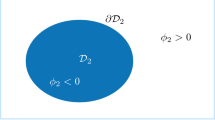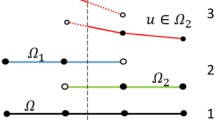Abstract
In the framework of Symmetric Galerkin Boundary Element Method, different techniques in these last years have been proposed to reduce the computational cost of the Galerkin matrix evaluation: in particular, the Panel Clustering Method [25,26] it is now largely used. On the other side, very recently a theory on restriction matrices has been developed to take computational advantage of possible symmetry properties of the differential or integral problem at hand [4,5]. Here we couple Panel Clustering Method with restriction matrices, presenting the most important algorithms employed and showing several examples, comparisons and numerical results.
Similar content being viewed by others
References
A. Aimi, M. Diligenti and G. Monegato, New numerical integration schemes for applications of Galerkin BEM to 2D problems, Int. J. Numer. Meth. Engng. 40 (1997) 1977–1999.
A. Aimi and M. Diligenti, Numerical integration in 3D Galerkin BEM solution of HBIEs, Comput. Mech. 28 (2002) 233–249.
A. Aimi, M. Diligenti, F. Lunardini and A. Salvadori, A new application of the panel clustering method for 3D SGBEM, CMES 4(1) (2003) 31–49.
A. Aimi, L. Bassotti and M. Diligenti, Groups of congruences and restriction matrices, BIT 43(4) (2003) 671–693.
A. Aimi, M. Diligenti, F. Freddi and A. Salvadori, Restriction matrices for SGBEM applications, Comput. Mech. 32 (2003) 430–444.
A. Aimi and M. Diligenti, Restriction matrices: Algorithms and computational issues, submitted.
E.L. Allgower, K. Georg, R. Miranda and J. Tausch, Numerical exploitation of equivariance, Z. Angew. Math. Mech. 78 (1998) 795–806.
H. Andrä, C. Polizzotto and E. Schnack, A boundary interior element discretization method for the analysis of two- and three-dimensional elastic-plastic structures, in: Finite Inelastic Deformations – Theory and Applications, eds. D. Beskos and F. Stein, IUTAM Symposium, Hannover, Germany (Springer-Verlag, Berlin, 1991) pp. 459–468.
L. Bassotti, Linear operators that are T-invariant with respect to a group of homeomorphims, Russian Math. Surveys 43(1) (1988) 67–101.
M. Bebendorf, Approximation of boundary element matrices, Numer. Math. 86 (2000) 565–589.
M. Bebendorf and S. Rjasanow, Adaptive low-rank approximation of collocation matrices, Computing 70 (2003) 1–24.
R. Bialecki and A.J. Nowak, Boundary value problems in heat conduction with nonlinear material and nonlinear boundary conditions, Appl. Math. Modelling 5 (1981) 417–421.
M. Bonnet, G. Maier and C. Polizzotto, Symmetric Galerkin boundary element method, Appl. Mech. Rev. 51 (1998) 669–704.
M. Bonnet, Exploiting partial or complete geometrical symmetry in 3D symmetric Galerkin indirect BEM formulations, Int. J. Numer. Meth. Engng. 57 (2003) 1053–1083.
A. Bossavit, Boundary value problems with symmetry and their approximation by finite elements, SIAM J. Appl. Math. 53(5) (1993) 1352–1380.
A. Bossavit, On the computation of strains and stresses in symmetrical articulated structures, Lectures in Appl. Math. 29 (1993) 111–123.
G. Chen and J. Zhou, Boundary Element Methods (Academic Press, London, 1992).
M. Costabel and W. Wendland, Strong ellipticity of boundary integral operators, Crelle's J. Reine Angew. Math. 372 (1986) 34–63.
M. Costabel, Boundary integral operators on Lipschitz domains: Elementary results, SIAM J. Math. Anal. 19(3) (1988) 613–626.
M. Diligenti and G. Monegato, Integral evaluation in the BEM solution of (hyper)singular integral equations. 2D problems on polygonal domains, J. Comput. Appl. Math. 81 (1997) 29–57.
C.C. Douglas and B.F. Smith, Using symmetries and antisymmetries to analyze a parallel multigrid algorithm: the elliptic boundary value problem case, SIAM J. Numer. Anal. 26 (1989) 1439–1461.
C.C. Douglas, Some nontelescoping parallel algorithms based on serial multigrid aggregation and disaggregation techniques, in: Multigrid Methods, Lecture Notes in Pure and Appl. Math. vol. 110 (1988) pp. 167–176.
G. Fossa, G. Maier, P. Masarati and G. Novati, Boundary element analysis in the presence of dihedral symmetry under general boundary conditions, in: Proc. 7th Inter. Conf. on Boundary Elements, Como Lake, Italy, A Computational Mechanics Publication (Springer-Verlag, Berlin, 1985).
K. Giebermann, Multilevel approximation of boundary integral operators, Computing 67(3) (2001) 183–207.
K. Giebermann, On the use of addition theorems for panel clustering, Preprint.
W. Hackbusch and Z.P. Nowak, On the fast Matrix multiplication in the boundary element method by panel clustering, Numer. Math. 54 (1989) 463–491.
W. Hackbusch, A sparse matrix arithmetic based on ℋ-matrices. Part I: Introduction to ℋ-matrices, Computing 62(2) (1999) 89–109.
W. Hackbusch and S. Sauter, On the efficient use of the Galerkin method to solve Fredholm integral equations, Appl. Math. 38 (1993) 301–322.
S. Kurz, O. Rain and S. Rjasanow, Application of the adaptive cross approximation technique for the coupled BE-FE solution of symmetric electromagnetic problems, Comput. Mech. 32 (2003) 423–429.
J.L. Lions and E. Magenes, Non-Homogeneous Boundary Value Problems and Applications I (Springer-Verlag, Berlin, 1972).
J. Lobry and C.H. Broche, Geometrical symmetry in the boundary element method, Engng. Anal. with Bound. Elem. 14 (1994) 229–238.
MATLAB, The Language of Technical Computing, The MathWorks (2000).
F.V. Postel and E.P. Stephan, On the h−, p− and h−p version of the boundary element method-numerical results, Comput. Meth. Appl. Mech. Eng. 83 (1990) 69–89.
S.A. Sauter, Variable order panel clustering, Computing 64 (2000) 223–261.
C. Schwab and W. Wendland, Kernel properties and representations of boundary integral operators, Math. Comput. Meth. Appl. Mech. Eng. 83 (1990) 69–89.
J.P. Serre, Linear representations of Finite Groups, Graduate Texts in Mathematics, Vol. 42 (Springer-Verlag, Berlin, 1977).
S. Sirtori, G. Maier, G. Novati and S. Micoli, A Galerkin symmetric boundary element method in elasticity: formulation and implementation, Int. J. Numer. Meth. Engng. 35 (1992) 255–282.
G.F. Smith, Projection operators for symmetric regions, Archive for Rational Mechanics and Analysis 54 (1974) 161–174.
J. Tausch, A generalization of the discrete Fourier transform, in: Exploiting Symmetry in Applied and Numerical Analysis, eds. E.L. Allgower, K. Georg and R. Miranda, Lectures in Applied Mathematics, Vol. 29 (Amer. Math. Soc., Providence, RI, 1993) pp. 405–412.
E. Tyrtyshnikov, Mosaic-skeleton approximations, Calcolo 33 (1996) 47–57.
Author information
Authors and Affiliations
Additional information
Communicated by M. Redivo-Zaglia
AMS subject classification
65F30, 65N38
Rights and permissions
About this article
Cite this article
Aimi, A., Diligenti, M. & Lunardini, F. Panel clustering method and restriction matrices for symmetric Galerkin BEM. Numer Algor 40, 355–382 (2005). https://doi.org/10.1007/s11075-005-8136-x
Received:
Accepted:
Issue Date:
DOI: https://doi.org/10.1007/s11075-005-8136-x




